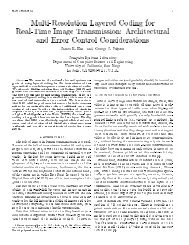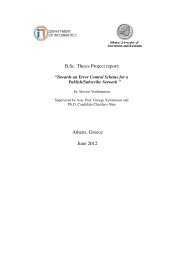In Network Processing and Data Aggregation in
In Network Processing and Data Aggregation in
In Network Processing and Data Aggregation in
You also want an ePaper? Increase the reach of your titles
YUMPU automatically turns print PDFs into web optimized ePapers that Google loves.
consumes more energy than the <strong>in</strong>itial sensor (as an accelerometer trigger<strong>in</strong>g a GPSreceiver), whereas <strong>in</strong> the case of network traffic a triggered imager for example generatesmuch less traffic than a constant video stream. <strong>In</strong> other words, <strong>in</strong>-network process<strong>in</strong>gmight choose the best application of a sparse resource (for example, a motion sensortrigger<strong>in</strong>g a steerable camera).COUGAR [5], [6]<strong>In</strong> order to enable declarative query<strong>in</strong>g of sensor networks, <strong>in</strong> [5],[6] is proposed aquery layer consist<strong>in</strong>g of a query proxy on every sensor node. Concern<strong>in</strong>g thearchitecture of the sensor node, the query proxy lies between the network layer <strong>and</strong> theapplication layer <strong>and</strong> it provides higher-level services us<strong>in</strong>g queries that can be <strong>in</strong>jected<strong>in</strong>to the network from a specified gateway node.Cougar, enables the user to parameterize the queries. A complex query may not onlyconsist of a large number of parameters <strong>and</strong> operators but also various user requirementson the query answers, such as specification of a maximum permissible latency <strong>and</strong>accuracy of the query result.Also, the query proxy is responsible for the data aggregation. Part of the computationcan be moved from a location outside the network <strong>and</strong> pushed <strong>in</strong>to the sensor network,aggregat<strong>in</strong>g records, or elim<strong>in</strong>at<strong>in</strong>g irrelevant records. Compared to traditionalcentralized data extraction <strong>and</strong> analysis, <strong>in</strong>-network process<strong>in</strong>g can reduce energyconsumption <strong>and</strong> improve sensor network lifetime significantly. This is the reason whyone of the ma<strong>in</strong> roles of the query proxy when process<strong>in</strong>g user queries is to perform <strong>in</strong>networkprocess<strong>in</strong>g.Nevertheless, COUGAR has some drawbacks as well. First, the addition of querylayer on each sensor node may add an extra overhead <strong>in</strong> terms of energy consumption<strong>and</strong> memory storage. Second, to obta<strong>in</strong> successful <strong>in</strong>-network data computation,synchronization among nodes is required (not all data are received at the same time from<strong>in</strong>com<strong>in</strong>g sources) before send<strong>in</strong>g the data to the leader node. Third, the leader nodesshould be dynamically ma<strong>in</strong>ta<strong>in</strong>ed to prevent them from be<strong>in</strong>g hot-spots (failure prone).As an example, suppose that we have a long-runn<strong>in</strong>g query Q to monitor the averagetemperature of an office every t seconds. The query Q notifies the adm<strong>in</strong>istrator of thenetwork if the average temperature <strong>in</strong> the office is greater than a user-def<strong>in</strong>ed threshold,








